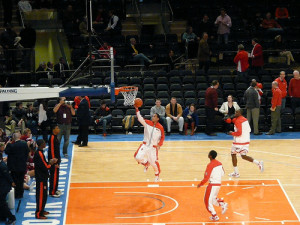How to Teach a Lay-up

The Lay-up is one of the most widely used shooting techniques a player will need to learn. Initially when talking about children playing basketball, the lay-up is the only shooting technique commonly used. While the lay-up is very much a fundamental skill, it does have a few challenges for those new to the sport and for those looking to improve its consistency.
One of the most commonly discussed issues around the lay-up, is the need for players to be able to lay-up on both the left and right side of the basket. While this is an obvious statement that very few coaches would ever undertake an argument against, there is the reality that many players very much favour one hand over the other when performing this skill. This results in players often substituting one hand over the other. This is something a coach must be very active in correcting, each and every time it happens in a training session or game. While not of evident immediate importance to a player in the early years of development, it will have very real and significant effects if a player cannot perform a lay-up technically perfectly on both the left and right side of the basket.
When teaching a lay-up there are some key teaching points:
- The opposite foot to the hand laying up the ball is jumped off. Often referred to as the inside foot, this leg provides the lift to elevate the player to the basket.
- The leg on the same side as the hand laying up the ball is driven up to help provide lift. For example if laying the ball up with the left hand, then the left leg is raised in the jump to help with drive towards the basket. The leg is bent at the knee and in doing so also help the player protect their space from the front.
- The jump has to be both up and towards the basket. All too often players jump up when performing a lay-up, but fail to drive themselves towards the basket. A nice teaching point to help players visualise this action is to ask them to try when performing the lay-up is to try and get as high as the backboard. When jumping the player should start their jump at the backboard, and finish under the basket.
- When the ball is picked up from the dribble the ball must come to make contact on the top of the chest and chin. This is often called “chinning” the ball. With two hands, the player’s chest and chin there are four points of contact with the ball that provide added stability and control. Additionally in this position, the ball can be quickly raised and also kept in the peripheral vision of the player when performing the lay-up.
- Once the ball is picked up, a player’s eyes should be focused on the basket. This is important as in performing this action and player will naturally move towards the target along the shortest and therefore, quickest route to the basket. Additionally, the longer the player focuses on the target the better their judgement should be when estimating distance and strength needed to perform the lay-up.
- Once the ball is raised past the forehead of the player the two hands separate and the inside arm extends to protect the body and ball from defenders to the front and side. This “off arm” cannot extend out of the players cylinder or risk an offensive foul, but this arm can be used to help protect the ball within the cylinder quite aggressively.
- The shooting hand should extend fully pushing through the ball and finishing with a flick of the wrist. The shooting arm in the lay-up will have a number of similar teaching points to that of a jump shot concerning the shooting arm.
- The ball should make a light touch off the backboard and into the basketball hoop. This technique is often referred to as a “soft touch”. This describes the speed and pace at which the ball is to be released and pushed off the backboard.
The lay-up is a vital fundamental skill and initially a lot of time will need to place around mastering this skill. Once the initial fundamental has been competently performed a player must quickly link the lay-up with dribbling and changing direction to ensure the technique becomes as game ready as possible.
Related articles







